|
Cara received an Honorable Mention for her research proposal submitted to the National Science Foundation Graduate Research Fellowship. Although not funded (so close!), the mention indicates the reviewers and NSF officers highly rated her proposal. Congratulations Cara!
0 Comments
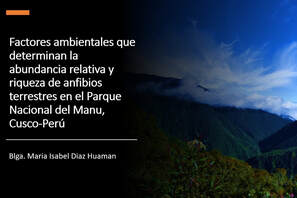 Isabel and Alessandro gave talks at the Segundo Simposio Peruano de Herpetologia at the Universidad Peruana Cayetano Heredia. Isabel's talk entitled "Factores ambientales que determinan la abundancia relativa y riqueza de anfibios terrestres en el Parque Nacional del Manu, Cusco-Perú" explored the effects of abiotic and biotic variables associated with variation in frog species richness, abundance and biomass in the montane forests of the Amazonian slopes of the Andes. 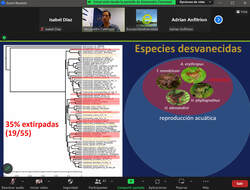 Alessandro gave a plenary talk on the first day of the symposium, "Dos décadas de investigaciones herpetológicas en los Andes Amazónicos", summarizing some of the taxonomic, ecological and conservation work that the lab has conducted over the years, with special emphasis on the current project monitoring disease transmission in terrestrial-breeding frogs in the cloud forests of Manu National Park. Both talks were given remotely. Congratulations to Rachel for being awarded a Smithsonian Tropical Research Institution short term fellowship! Rachel is conducting behavioral and ecological studies at STRI in Panama for most of the year.
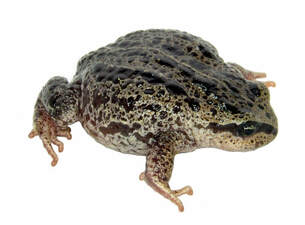 The lab contributed to the description and naming of a new species of high Andean terrestrial breeding frog, Phrynopus apumantarum. The study, led by collaborator Germán Chávez, appeared today in the journal Evolutionary Systematics. The new species (see holotype in the picture) is the southernmost species of the genus, which has 34 more species mostly distributed in central Peru. The epithet apumantarum derives from Quechua word apu (=mountain spirit), and from the name Mantaro which is the main river of the Valley where the new species was discovered. Citation: Chávez, G., L. A. Garcia-Ayachi, A. Catenazzi. 2023. A new species of frog (Terrarana, Strabomantidae, Phrynopus) from the Peruvian Andean grasslands. Evolutionary Systematics 7: 105-116.
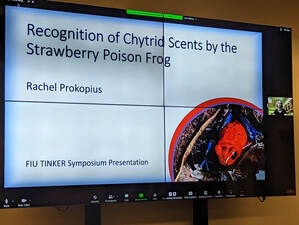 Two lab members gave talks today at the Tinker Field Research Symposium at the Latin American and Caribbean Center at FIU. The Tinker Foundation supports travel and field research for many FIU graduate students. Rachel connected from STRI in Panma and presented her research on Recognition of chytrid scent by the strawberry poison frog. Jon presented gave his talk on Transmission of chytridiomycosis in terrestrial breeding frogs in Andean montane forests. 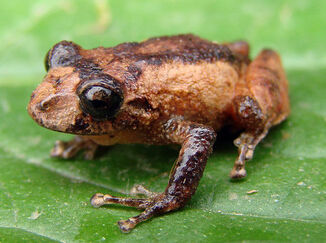 Our lab contributed to the first report of Ranavirus presence in Colombia. Colombia is one of the most biodiverse countries for amphibians, boasting record numbers of frog and caecilian species. The study found Ranavirus in 14 of 274 individuals from 8 of 41 sampled localities, including highland and lowland sites. Infected frogs represented five native species of the genera Osornophryne, Pristimantis (such as P. bogotensis of the photo by Giovanni Alberto Chaves Portilla) and Leptodactylus, as well as the invasive American bullfrog Rana catesbeiana. Ranavirus can cause systemic hemorrhages, erythema on the lips, regurgitation, bleeding, muscle abnormalities and ulceration in infected amphibians. Ranavirus outbreaks have coincided with mass die off in amphibian populations, as documented in North America and Europe. However, little is known about the distribution and consequences of Ranavirus infection in tropical mountains and forests, where emergent diseases threaten amphibian biodiversity. The study is led by Dr. Vicky Flechas, and has been published in the journal Diseases of Aquatic Organisms. Citation: Flechas, S. V., J. Urbina, A. J. Crawford, K. Gutierrez, K. Corrales, L. A. Castellanos, M. A. González, A. M. Cuervo, and A. Catenazzi. First evidence of Ranavirus in native and invasive amphibians in Colombia. Diseases of Aquatic Organisms 16: 153:51-58. doi: 10.3354/dao03717.
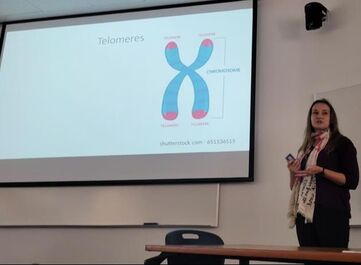 Congrats to Anne for winning the award for the best 15 minute talk at the 2023 FIU Biosymposium! She presented the results of her research on the impact of carbon nanoparticles on the growth, development, and telomere length of tadpoles of the invasive Cuban treefrogs (Osteopilus septentrionalis). Nanoparticles such as carbon dots could disrupt the development of amphibian larvae, as seen in zebrafish embryos. Anne's experiment however did not detect variation in development and telomere length. 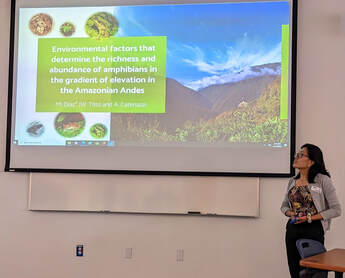 Isabel gave the second lab presentation in the 5 minute 'lightning' talks session, titled Environmental factors that determine the richness and abundance of amphibians in the elevational gradient of the Amazonian Andes. Her research, part of her undergraduate thesis, explored the influence of variables such as soil pH, soil nutrient concentration, and vegetation structure and canopy coverage on the distribution of montane and high-elevation terrestrial frogs in Manu National Park in southern Peru. The FIU Biosymposium is an annual celebration of research conducted by Graduate Students in the Biological Sciences at FIU. The purpose of the meeting is to allow students to present their projects and results in a friendly, yet professional, atmosphere, and to provide opportunities for prospective graduate students to meet students and learn about FIU research.
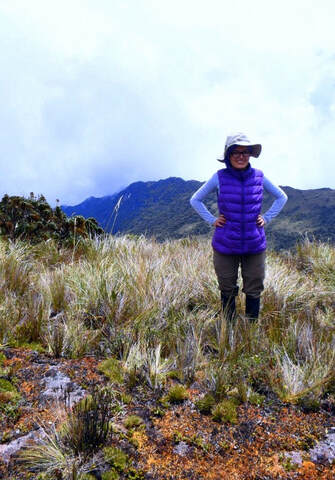 The lab welcomes Isabel Diaz, a new PhD student in the program. Isabel has been collaborating with lab research since 2015, and coauthored the description of Bryophryne phuyuhampatu in 2017. She graduated from the National University San Antonio Abad of Cusco, and she is also associated with the local Museo de la Biodiversidad (MUBI). For her undergraduate thesis, she investigated the importance of abiotic factors on the composition, species richness and relative abundance of leaf-litter frogs along an altitudinal gradient in the Amazonian Andes of Manu National Park, Cusco. Her research interests include the ecology, evolution and conservation of amphibians and reptiles. She has been involved with our NSF-funded project investigated fungal pathogen (chytrid) transmission among terrestrial-breeding frogs in the eastern slopes of the Andes since its beginning in May of 2021. 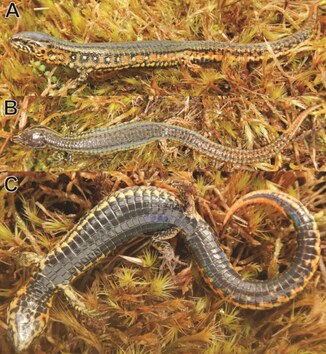 In a collaboration led by Dr. Edgar Lehr of Illinois Wesleyan University and colleagues at the Museo de Historia Natural de la Universidad Nacional de San Marcos in Lima, we described and named a species of high-elevation lizard as Proctoporus titans. Proctoporus are small to medium sized lizards that inhabit the montane forests and high-elevation grasslands of the tropical Andes, from central Peru to Bolivia. Their diversity is likely underestimated, and new species continue to be discovered every year. This is the second species described, in less than one year, from the poorly explored Otishi National Park in the steep mountains of the Cordillera de Vilcabamba. Citation: Lehr, E., J.C. Cusi, M.I. Fernandez, R.J. Vera, and A. Catenazzi. 2022. A new species of Proctoporus (Reptilia, Gymnophthalmidae, Cercosaurinae) from the puna of the Otishi National Park in Peru. Taxonomy 3: 10-28.
A new lab contribution led by Yiqun Zhou and the group of Roger LeBlanc at the University of Miami published this week in the Royal Society of Chemistry's journal Nanoscale examines whether carbon nitride dots (CND), a type of carbon-based nanomaterial, can act as nucleobase analogs. Although the physicochemical property characterization demonstrated that adenine- and cytosine-incorporated CNDs are similar, guanine-, thymine- and uracil-incorporated CNDs did not exhibit as many similarities in their properties, morphology, and structure. Exposing developing zebrafish embryos to CNDs interrupts development, but the causes do not seem to be related to CNDs directly interfering with DNA replication, as shown in experiments comparing amplification of the zebrafish polymerase-alpha 1 gene in quantitative polymerase chain reactions. The embryogenesis interruption by bare and nucleobase-incorporated CNDs might thus not be a consequence of CND–DNA interactions during DNA replication. Instead, CND–Ca2+ interactions offer a plausible mechanism that hindered cell proliferation and zebrafish embryogenesis originating from disturbed Ca2+ homeostasis by CNDs.
|
Archives
March 2024
CATENAZZI LABNews from the lab Categories |
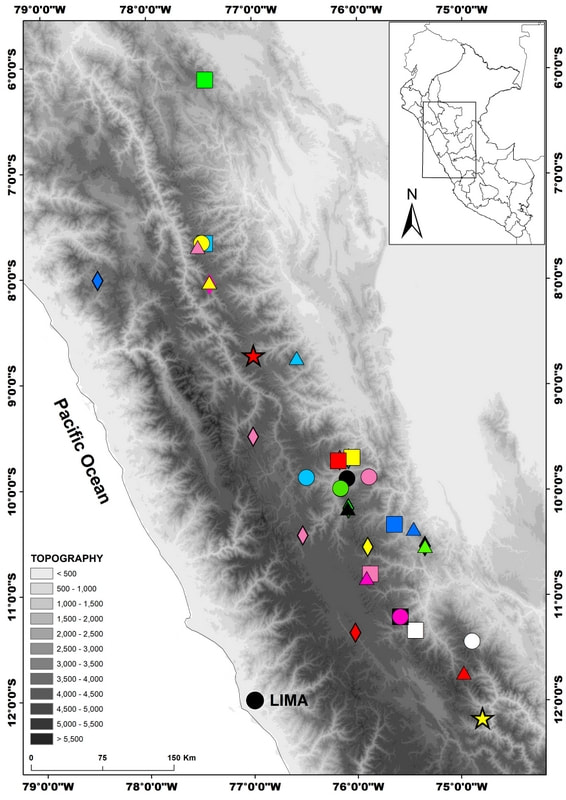
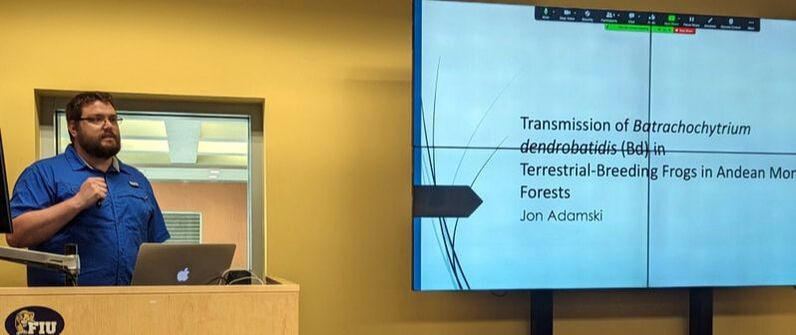
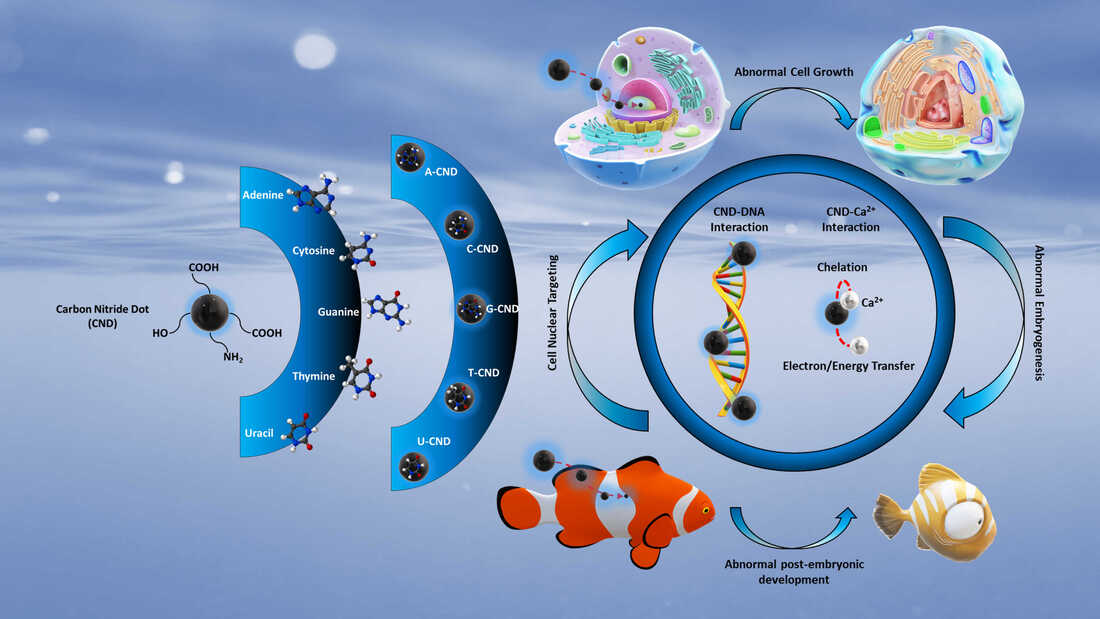
 RSS Feed
RSS Feed